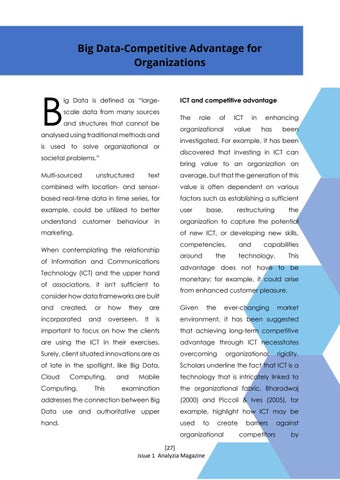Big Data-Competitive Advantage for Organizations
B
ig Data is defined as “largescale data from many sources and structures that cannot be
analysed using traditional methods and is used to solve organizational or societal problems.” Multi-sourced
ICT and competitive advantage The
role
of
ICT
organizational
in
value
enhancing has
been
investigated. For example, it has been discovered that investing in ICT can bring value to an organization on
unstructured
text
average, but that the generation of this
combined with location- and sensor-
value is often dependent on various
based real-time data in time series, for
factors such as establishing a sufficient
example, could be utilized to better
user
understand customer
organization to capture the potential
behaviour
in
marketing.
of Information and Communications Technology (ICT) and the upper hand of associations, it isn't sufficient to consider how data frameworks are built created,
incorporated
restructuring
the
of new ICT, or developing new skills,
When contemplating the relationship
and
base,
or and
how
they
around
technology.
the
capabilities This
advantage does not have to be monetary; for example, it could arise from enhanced customer pleasure. Given
the
ever-changing
market
environment, it has been suggested
important to focus on how the clients
that achieving long-term competitive
are using the ICT in their exercises.
advantage through ICT necessitates
Surely, client situated innovations are as
overcoming
of late in the spotlight, like Big Data,
Scholars underline the fact that ICT is a
Cloud
Mobile
technology that is intricately linked to
examination
the organizational fabric. Bharadwaj
addresses the connection between Big
(2000) and Piccoli & Ives (2005), for
Data use and authoritative upper
example, highlight how ICT may be
hand.
used
Computing.
This
and
It
and
is
Computing,
overseen.
are
competencies,
to
organizational
create
organizational [27] issue 1 Analyzia Magazine
barriers competitors
rigidity.
against by






